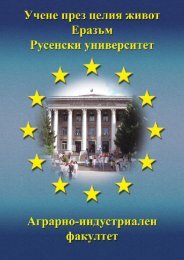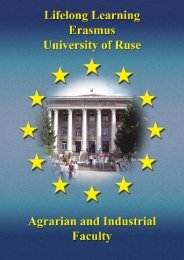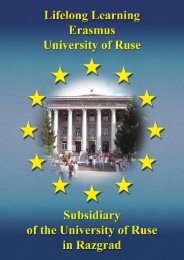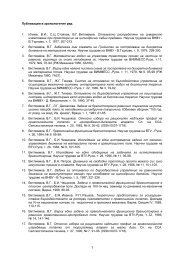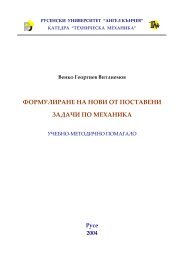Erasmus ECTS Information Package
Erasmus ECTS Information Package
Erasmus ECTS Information Package
Create successful ePaper yourself
Turn your PDF publications into a flip-book with our unique Google optimized e-Paper software.
<strong>Erasmus</strong> <strong>ECTS</strong> <strong>Information</strong> <strong>Package</strong><br />
Faculty of EEEA<br />
3230 Fundamentals of Automation<br />
<strong>ECTS</strong> credits: 5<br />
Weekly classes: 2lec+0sem+0labs+2ps+1ca<br />
Assessment: exam<br />
Type of exam: written<br />
Departments involved:<br />
Department of Automatics and Mechatronics<br />
Faculty of Electrical Engineering, Electronics and Automation<br />
Lecturers:<br />
Assoc. Prof. Valentin Bogdanov Stoyanov, MEng, PhD, Department of Automatics and Mechatronics,<br />
tel.: 082 888 372, Е-mail: vstojanov@uni-ruse.bg<br />
Assoc. Prof. Donka Ilieva Ivanova, MEng, PhD, Department of Automatics and Mechatronics , tel.: 082 888 266,<br />
Е-mail: divanova@uni-ruse.bg<br />
Abstract:<br />
The subject gives knowledge of automation control systems of the technological objects. During the lectures<br />
students are introduced into the principles and technical realization of transducers, controllers and actuators. The<br />
course is linked to the following subjects: Automation systems in power supply, Electronic devices and systems in<br />
agriculture and food production, etc.<br />
Course content:<br />
The structure of an automation system. Types. Transfer function. Dynamic characteristics. Models and dynamic<br />
elements connection. Technology processes and objects for control. Automation measurements of basic<br />
technology values. Industrial controllers. Actuators and valves.<br />
Teaching and assessment:<br />
Lectures introduce the basic topics from the course syllabus. The seminars follow the lecture topics. The student<br />
prepares individual reports. The workshops’ evaluation is taken into account in the final assessment of the student.<br />
3231 Electrical Machines I<br />
<strong>ECTS</strong> credits: 7<br />
Weekly classes: 3lec+0sem+3labs+0ps<br />
Assessment: exam<br />
Type of exam: written<br />
Departments involved:<br />
Department Electrical Power Engineering<br />
Faculty of Electrical Engineering, Electronics and Automation<br />
Lecturers:<br />
Assoc. Prof. Dimo Nejkov Dimov, MEng, PhD, Department of Electrical Power Engineering, tel.: 082 888 659,<br />
E-mail: dnd@uni-ruse.bg<br />
Abstract:<br />
The course objective is to acquaint the students with transformers and direct current machines arrangement,<br />
principle action, theory, characteristics and research methods.<br />
Course pre-requisites include Higher Mathematics, Physics and Theory of Electrical Engineering , Electrical<br />
Materials Science and Electrical Measurements.<br />
The course has output links with Electrical Machines 2, Electrical Transport, Electrical Drive and Electrical<br />
Equipment.<br />
Course content:<br />
General issues of the electrical machines theory. General knowledge of the machines. Structure and principle<br />
action of direct current machines. Armature windings. Inducing electromotive force in the armature windings.<br />
Electromagnetic torque. Commutation. Direct current generators and motors. Types. Characteristics. Special types<br />
of direct-current motors. Electrical machines with electronic commutation. Transformers arrangement and principle<br />
action. Modes of operation. Winding and group connection. Harmonic content of the magnetization current. Work<br />
in parallel. Special transformer types.<br />
Teaching and assessment:<br />
The theoretical basic issues on all topics from the syllabus, presented at the lectures, are further practised during<br />
the laboratory exercise. The students must prepare for the laboratory exercise in advance. The exam is conducted<br />
in written form and consists of two subject questions. The final exam mark depends on the mark received on the<br />
laboratory exercise.<br />
64



